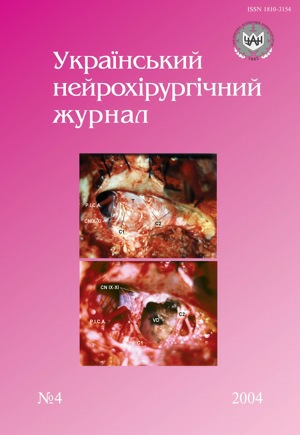The history of Copaxone is the history of the fight against multiple sclerosis
Abstract
No abstract.
References
Волошина Н.П., Шестопалова Л.Ф., Негреба Т.В. та ін. Копаксон у лікуванні хворих на розсіяний склероз // Нова медицина. — 2002. — № 2. — С.34–36.
Жученко Т.Д. Світовий і російський досвід застосування препарату Копаксон у хворих на розсіяний склероз // Нова медицина. — 2002. — № 2. — С.37–39.
Рассеянный склероз. Избранные вопросы теории и практики / Под ред. И.А.Завалишина, В.И.Головкина. — М., 2000. — 638 с.
Aharoni R., Teitelbaum D., Sela M. et al. Сopolimer 1 induces T-cells of the T-helper type 2 that crossreact with myelin basic protein and suppress experimental autoimmune encephalomyelitis // — Proc. Natl. Acad. Sci. USA. — 1997. — V. 94, N20. — P. 10821–10826.
Boneschi F.M., Rovaris M., Johnson K.P. et al. Effect of Glatiramer Acetate on relapse rate and accumulated disability in multiple sclerosis: meta-analysis of three double-blind, randomized, placebo-controlled clinical trials // Multiple sclerosis. — 2003. — V.9. — P. 349–355.
Bornstein M.B., Miller A., Slagle S. et al. A pilot trial of COP1 inexacerbating-remitting multiple sclerosis // New Engl. J. of Med. — 1987. — V.317, N7. — P.408–414.
Bornstein M.B., Miller A., Slagle S. et al. A placebo-controlled, double-blind, randomized, two-center, pilot trial of COP1 inchronic progressive multiple sclerosis // Neurology. — 1991. — V.41. — P.533–539.
Comi G., Filippi M., Wolinsky J.S. et al. European/Canadian multicenter, double-blind, randomized, placebo-controlled study of the effects of Glatiramer Acetate on Magnetic Resonance Imaging — measured disease activity and burden in patients with relapsing multiple sclerosis // Ann. Neurol. — 2001. — V.49. — P. 290–297.
Coyle P.K., Johnson K., Pardo L. et al. Pregnancy outcomes in patients with multiple sclerosis treated with Glatiramer Acetate (Copaxone) // Neurology. — 2003. — V.60, suppl. 1. — P.118.
Duda P.W., Schmied M.C., Cook S.L. et al. Glatiramer Acetate (Copaxone) induces degenerate, Th2-polarized immune responses in patients with multiple sclerosis // J. Clin. Invest. — 2000. — V.105. — P. 967–976.
Filippi M., Rovaris M., Rocca M.A. et al. Glatiramer Acetate reduces the proportion of new MS lesions evolving into “black holes” // Neurology. — 2001. — V.57. — P.731–733.
Gran B., Tranguill L.R., Chen M. et al. Mechanisms of immunomodulation by Glatiramer Acetate // Neurology. — 2000. — V.55. — P.1704–1714.
Johnson K.P., Brooks B.R., Cohen J.A. et al. Copolymer 1 reduces relapse rate and improves disability in relapsing-remitting multiple sclerosis: results of a phase III multi-center, double-blind, placebo-controlled trial // Neurology. — 1995. — V.45. — P.1268–1276.
Johnson K.P., Brooks B.R., Cohen J.A. et al. Extended use of glatiramer acetate (Copaxon) is well tolerated and maintains its clinical effect on multiple sclerosis relapse rate and degree of disability // Neurology. — 1998. — V. 50. — P. 701–708.
Johnson K.P., Brooks B.R., Ford C.C. et al. Sustained clinical benefits of glatiramer acetate in relapsing multiple sclerosis patients observed for 6 years // Multiple sclerosis. — 2000. — V. 6. — P. 255–266.
Khan O.A., Tselis A.C., Kamholz J.A. et al. A prospective, open-label treatment trial to compare the effect of IFN b –1a (Avonex), IFN b –1 b (Betaseron), and Glatiramer Acetate (Copaxone) on the relapse rate in relapsing-remitting multiple sclerosis // Europ. J. Neurol. — 2001. — V.8, N2. — P.141–148.
Neuhaus O., Farina C., Wekerle H. et al. Mechanisms of action of Glatiramer Acetate in multiple sclerosis // Neurology. — 2001. — V.56. — P.702–708.
Teitelbaum D., Milo R., Arnon R., Sela M. Synthetic copolymer–1 inhibits human T-cell lines specific for myelin basic protein // Proc. Natl. Acad. Sci. USA. — 1992. — V. 89. — P. 137–141.
Teitelbaum D., Aharoni R., Sela M. Et al. Cross-reactions and specificities of monoclonal antibodies against myelin basic protein and against the synthetic copolymer–1 // Proc. Natl. Acad. Sci. USA. — 1991. — V. 88. — P. 9528–9532.
Downloads
How to Cite
Issue
Section
License
Copyright (c) 2004 L. I. Sokolova

This work is licensed under a Creative Commons Attribution 4.0 International License.
Ukrainian Neurosurgical Journal abides by the CREATIVE COMMONS copyright rights and permissions for open access journals.
Authors, who are published in this Journal, agree to the following conditions:
1. The authors reserve the right to authorship of the work and pass the first publication right of this work to the Journal under the terms of Creative Commons Attribution License, which allows others to freely distribute the published research with the obligatory reference to the authors of the original work and the first publication of the work in this Journal.
2. The authors have the right to conclude separate supplement agreements that relate to non-exclusive work distribution in the form of which it has been published by the Journal (for example, to upload the work to the online storage of the Journal or publish it as part of a monograph), provided that the reference to the first publication of the work in this Journal is included.









